Installing a wall-hung toilet: we analyze the nuances of installation technology
Floor-standing toilets have been out of competition for a long time, but everything is changing.Owners of modern apartments are increasingly choosing hanging models. This pleasure is not cheap, but this is practically the only drawback of this solution. But among the advantages of the design are its excellent design and ease of maintenance.
It is important that the installation of a wall-hung toilet is carried out in accordance with all the rules. We will tell you how and in what sequence the work is carried out, what devices will be needed to attach the bowl. Taking into account our recommendations, you can do everything yourself or supervise the actions of plumbers.
The content of the article:
How is the suspended structure constructed?
A home craftsman can easily handle the installation of a wall-mounted model if he understands the distinctive features of its design.
The visible element of such a plumbing fixture is the toilet bowl itself. Its installation on the wall is carried out in two ways: using an installation and on a concrete base. In our article we will look at both options.

The strengths and weaknesses of the suspended type of plumbing are listed in the article, which describes in detail the varieties and design specifics, and provides guidelines for choosing the optimal model for you personally.
The design of a wall-mounted plumbing fixture can be roughly divided into three main elements, which will be discussed further.
Reliable steel frame (module)
The frame is the main element of the entire structure, which is attached to the floor and wall of the bathroom. It is the frame that supports the cistern and bowl. The quality of subsequent operation of the product depends on its reliability. After putting the toilet into operation, the structure will need to have a sufficient margin of strength to support the weight of an adult.
To secure the frame, you must have a solid base. Plasterboard walls cannot be considered in this capacity. The frame is equipped with a mechanism that allows you to vary the installation height of the toilet bowl in the range of 40-43 cm. To securely fasten the bowl, manufacturers recommend using strong pins made of steel.
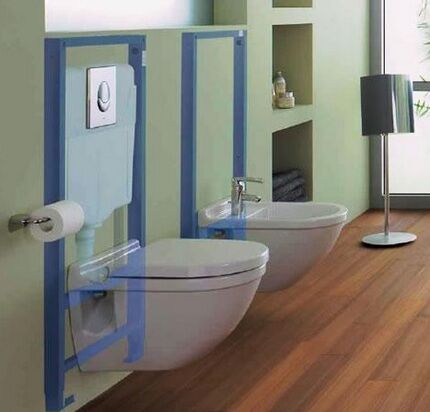
The Best Support Frame Models for Wall Hanging Plumbing Fixtures Listed in the article, which we recommend that you familiarize yourself with.
Hidden cistern
The hidden fastening of this element, according to supporters of the wall model, is considered one of the advantages of the design. The material for its manufacture is very durable plastic. To prevent condensation from accumulating on the surface, the plastic is treated with styrene.
The tank has a flat shape, distinguished by a technological cutout on one side.This cutout is necessary for the drain key device. This hole has another purpose: it allows you to remove the drain tank fittings when performing repair work.
Another feature of hanging tanks is the economical drainage system that such a model can be equipped with. Depending on the need, the drain dose can be 3 or 6 liters.
The bowl is a visible structural element
The bowl is chosen, as a rule, based on the personal preferences of the users. It is in plain sight and must correspond to the overall interior of the room. Besides, selected wall hung toilet should be easy to use.
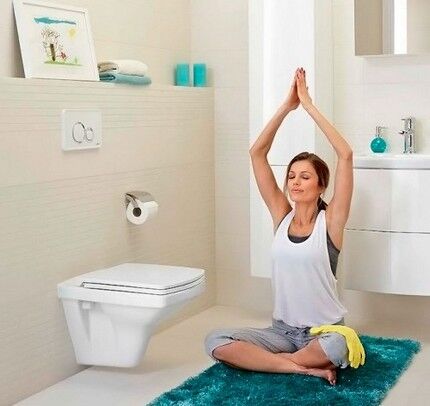
Most buyers prefer an oval-shaped product. Although there are round, rectangular and even square models on sale.
Fastening elements are part of the selected model and are included in its configuration. There is no need to purchase additional hardware for a wall-hung toilet. In addition, among the mounted models there are smart plumbing devices with electronic control and numerous hygienic functions.
Intelligent types of plumbing fixtures with retractable nozzles for washing and drying, deodorizing and other actions need to be connected to a power supply. Their installation is complicated by connecting the power line and setting up the system:
Careful assessment of pros and cons
When choosing a more modern model, you need to think carefully about whether it makes sense to unconditionally give preference to such a solution or whether you should still prefer the traditional option.
What attracts users to the suspended model and what makes them doubt it?
- Design. The laconic appearance of the product is a definite plus. An elegant bowl that does not touch the floor looks more aesthetically pleasing than the one that is built into it. The panel covering the installation site looks attractive. You can also select a suitable flush key option.
- Compact placement. This statement, by the way, causes controversy among experts. If we talk about the real, and not about the visual effect, then it is small. To install the installation not in a niche, you need about 15 cm. Let's add the thickness of the false wall to this value and make sure that the gain is not as great as we would like.
- Easy to maintain. The absence of a foot makes it easy to clean the space under the toilet.There is no hole in the floor that causes problems with cleaning and could disrupt the overall pattern of the floor covering.
- Repair work. Closed communications are good only if they work properly. In the event of a breakdown, access to them can be very difficult, and restoration of the interior can be expensive. Difficulties may also arise with repairing the tank if it is still needed.
- Psychological aspect of exploitation. The frame of the device is reliable enough to withstand loads of up to 400 kg. But overweight people may experience psychological difficulties when using this plumbing fixture: the fear that the bowl may come off and break. It is very difficult to relax in such a situation.
- Features of installing a wall-hung toilet. Of course, installing a wall model is more difficult than a floor model. To successfully complete your plan, you must either spend additional money by inviting specialists, or energy and time if you decide to do the work yourself.
- Price. A wall model will cost you more than a floor model. This difference in price can be attributed to the cost of the steel installation, so the option of installation on a concrete base can be considered the most budget-friendly.
In fact, apart from a nice appearance, the popular and fashionable model does not have any special advantages. This is rather a matter of taste of the owners. Therefore, if you are on a budget, think again: is the result worth the expected cost?
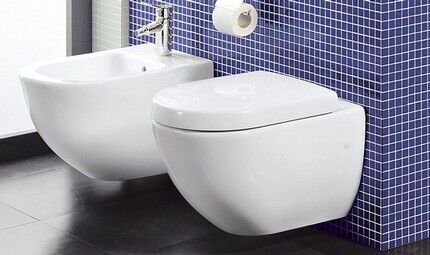
Preparation for installation work
As always, we advise you to purchase everything you need to complete the job in advance and have it on hand.
So, to install a wall-hung toilet with installation, you need to have:
- steel frame-module complete with a plastic tank (container);
- toilet bowl;
- flush key;
- steel studs for fastening work;
- set of connecting pipes.
Usually, the installation kit includes not only a plastic container, but also a flush key, pipes, adapters and fasteners. As a rule, the kit also includes special material to protect the entire structure, which will be located in the wall of the bathroom, from condensation. The same material reduces the noise level during the period of draining and filling the container with water.
When you buy plumbing fixtures in a store, be sure to check the package and purchase additional items that you need but are not included in the basic set. Please note that the bowl is usually purchased separately. The frame itself and all mounting elements are standardized, so choose the option that you like.
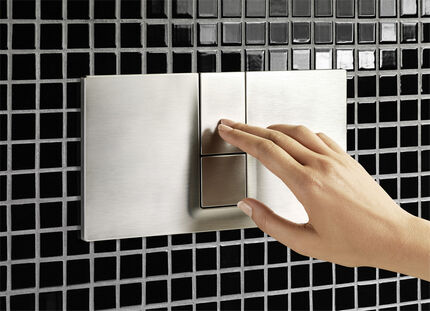
Most buyers prefer a double flush button: it allows you to dose the water flow. To perform installation and finishing, you will need moisture-resistant drywall.
Don't forget about the tools. You will need:
- perforator;
- concrete drills;
- roulette;
- pencil for marking;
- spanner wrenches;
- building level;
- knife for working with drywall.
Prepare the work area: remove all unnecessary items. We can start.
Installation work with installation
So that you can imagine how you will install a wall-hung toilet, we list the main stages of the work.
You will:
- equip a niche in the wall of the bathroom with the appropriate parameters;
- bring the sewer pipe to the installation point;
- secure the frame module;
- install cold water supply pipes;
- connect the plastic tank;
- install a false wall and perform finishing work;
- secure the bowl by connecting it to the sewer inlet and flush tank.
At the end of the installation procedures, you should correctly connect the flush key.
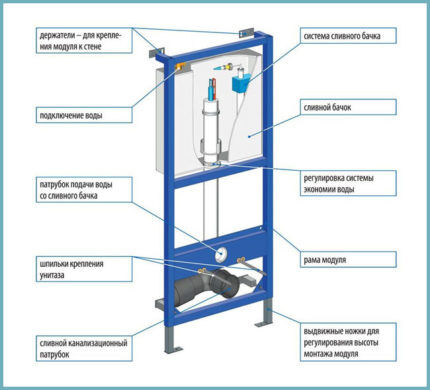
The implementation of each of the listed stages must be approached as responsibly as possible, so that errors and negligence do not increase the cost of your effort, time and money.
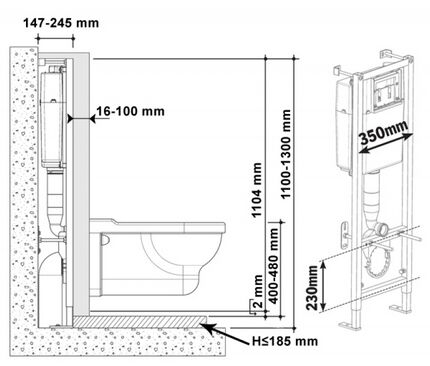
What should be the niche for the installation?
There are several important requirements for organizing a niche. Firstly, the walls you have to work with must have a certain load-bearing capacity. We have already spoken about plasterboard walls above: they are not suitable for our purpose.
Ideally, the frame should withstand a load of up to 400 kg. This load is distributed between the walls and the floor, so the walls must be strong and reliable.
It is necessary to hollow out a recess in the wall 1000 mm high, 600 mm wide and 150-200 mm deep. If everything is clear with height and width, then the required depth may not be there. Then you should hollow out as much as you can, and disguise the lack of depth with finishing.
As a camouflage, you can suggest building a cabinet between the wall and the resulting ledge for all sorts of little things appropriate for the bathroom and household chemicals. Or even make open shelves.
Some apartment owners, in order to reduce the amount of work, decide to install the frame close to the wall, and then cover it with plasterboard. It is in this case that the advantage of the model in terms of saving bathroom space almost completely disappears.
Those who do not live on the upper floors of apartment buildings may come up with the idea of adapting a niche for mounting the frame fan boner. In this case, part of the vent riser is cut off, and an air valve is placed at the point where it discharges into the attic. It is better not to do such work without the approval of the management company and without specialists.
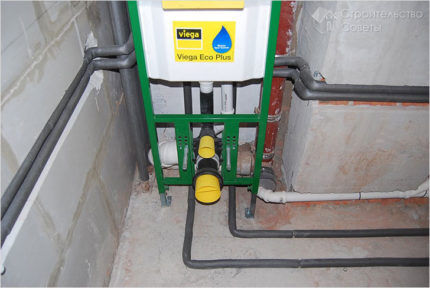
If your bathroom has a ready-made niche, which is provided for by the building design, consider yourself lucky. It can be used. But the sewer pipes and cold water supply sometimes have to be adjusted.
How to install a sewer?
A sewer pipe must be connected to the installation site of the hanging system toilet. To do this, choose one with a diameter of 100 mm. The pipe is installed as close to the floor as possible while maintaining the required slope.
To determine the location of connection to the sewer, you need to measure 250 mm from the center of the niche. It's here. Now you need to install an oblique bend on the horizontal part of the pipe, the angle of which is 45 degrees. That's it, let's move on to the next step.
How to secure the frame with the container?
The frame must be secured at four points, two of which are legs that are attached to the floor. At two more points the frame is attached to the wall using brackets. Installable design must be positioned perfectly evenly in both horizontal and vertical planes. Do not forget to check the quality of installation using a building level.
To adjust the vertical position of the module, use the legs of the product. Correct horizontal placement is achieved by changing the length of the wall fastenings.
The installation is screwed to the wall only after its position has been thoroughly checked. For additional fixation of the module, its legs can be cemented. The optimal depth of the screed layer is 20 cm. This precaution is not necessary.

The slightest distortion of the structure will inevitably lead to premature breakdowns and, as a result, to serious financial losses for the owner.
Pay attention to the bottom of the installation. At a distance from the floor of approximately 300-400 mm, there are several holes in the frame intended for subsequent installation of the toilet bowl.
There are special studs for these holes, which need to be inserted into them, equipped with the appropriate nuts and attached to the wall. These pins are used to make hanging bowl mount.
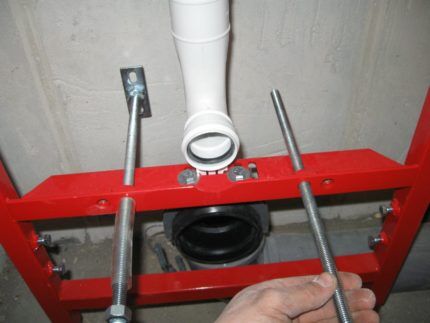
Connecting the necessary communications
First of all, we connect the sewer.For this connection, a black tap is used, which, as a rule, is included in the installation package. One end of this outlet is adjusted to the sewer pipe, and its other end is attached to the frame with special clips.
Water pipes should be located to the right or left of the module. The pipe should be connected to the structure using the threaded connection already present in it. To connect the water supply, it is better to use copper or polypropylene pipes, and make the connection detachable.
Cold water can also be supplied to the tank using flexible hoses. Such hoses are more profitable in terms of price, but their fragility should be taken into account. And when replacing failed hoses, you will have to carry out expensive repairs, so the option with pipes is still preferable.
Don't forget to check how securely the drain container is connected to the water supply system. For this purpose, open the water supply tap. It is located inside the drain tank. After filling the container, all possible leaks are eliminated. This can be done without draining the water.
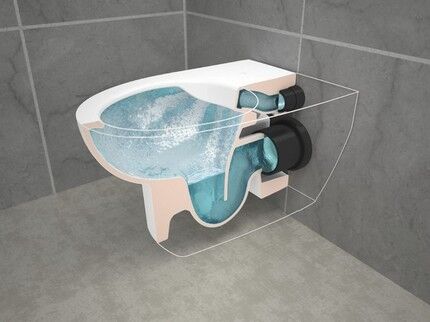
The connection to the sewer drain should also be checked. To do this, put a toilet bowl on the studs and perform a test flush without finally securing the structure. After which the bowl is removed again and all identified leaks, if any, are eliminated.
Finishing work
At the next stage, you will have to sew up the niche using a moisture-resistant sheet of plasterboard, and then carry out the finishing work.Please note that we need moisture-resistant drywall, because regular drywall will quickly deteriorate under the influence of condensation.
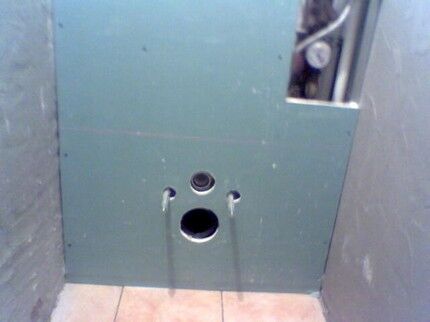
To cut drywall, you need to use a template, which should be included with the installation. It will allow you to correctly cut all the necessary mounting holes without damaging the material.
After installing the moisture-resistant sheet, finishing material can be fixed to its surface. Ceramic tiles are most often used to decorate a bathroom.
Final installation steps
You can begin installing the visible part of the wall-hung toilet only after the tile adhesive has thoroughly dried.
The procedure for installing a toilet bowl:
- the drainage pipe must protrude 50 mm beyond the wall surface: it must be adjusted to this size;
- do the same with the pipe that leads to the sewer drain;
- both pipes are installed in the places intended for them;
- a large gasket similar in shape to a truncated pyramid is put on the studs that were fixed in advance, as well as on the pipes;
- the bowl is put on the studs and the pipes are attached to it;
- put rubber gaskets and plastic inserts in their places;
- put on and tighten the fastening nuts;
- The protruding parts of the rubber gasket are carefully trimmed.
Now you can drain the water from the tank, thereby checking the operation of the sewer drain.The installation height of the wall-hung toilet bowl relative to the floor can be adjusted by changing the position of the studs and retractable pins that are used to secure this element. It must match the height of the toilet visitors.
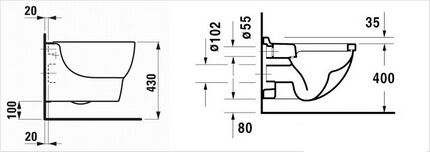
The standard height is 40 cm, measured from the floor surface to the top edge of the bowl.
Attaching the flush key
The installation process is completed by installing the drain key. It is included in the basic package and can be mechanical or pneumatic. Usually this procedure does not cause any problems, since all the provided connections should already be brought to the surface of the wall.
There are special pins for a mechanical key, and tubes for a pneumatic key. All that remains is to install this element in its intended place and adjust its position. That's it: the toilet can be used.
Suspended model on a concrete base
A steel frame is expensive. In principle, you can do without it by building a concrete pedestal with your own hands, which will serve as a reliable foundation for the wall-hung toilet. This option is considered the most economical.
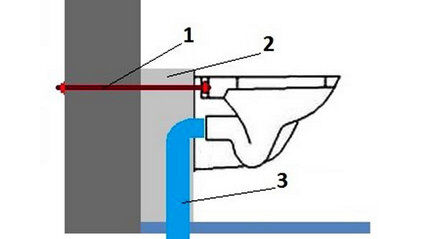
With this installation method, the drain container can either be mounted into the wall, with the drain button located outside, or placed above the bowl of the plumbing fixture.
Pre-installation procedure
Let's consider the option that is considered the least expensive.Let's prepare everything you need for work:
- concrete M200 - approximately 40 liters;
- boards for making formwork;
- threaded rods (length 50-80 cm, thickness 2 cm) - 2 pieces;
- washers, nuts, screws for woodworking;
- plastic pipe (diameter 11 cm, length 8 cm);
- drain coupling;
- Styrofoam;
- silicone sealant.
I think it’s worth repeating that the wall we have to work with must be permanent.
Step-by-step installation process
We fix rods in the main wall, onto the outlets of which the toilet bowl will then be placed. Let us remind you that we must have a stable and reliable structure that can withstand a weight of 400 kg.
The next step is to install the drain coupling. At this stage, it is necessary to determine the height of the toilet in order to cut the coupling to the appropriate length.
Now we need to install the formwork. In order to mark fastening points on the formwork, you should determine the distance between the holes intended for fastening.
To calculate the length of the rods, you need to add up the thickness of the recess, which is approximately 15 cm, and the distance from the wall to the toilet bowl. To fix the rods in the wall, concrete adhesive is used - a chemical anchor.
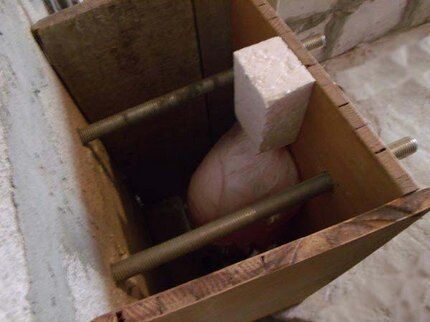
When the formwork is installed and the installation of the pins is completed, the bowl should be installed in the place intended for it. Make sure that the mounting holes match the outlets, and the outlet hole matches the coupling drain.
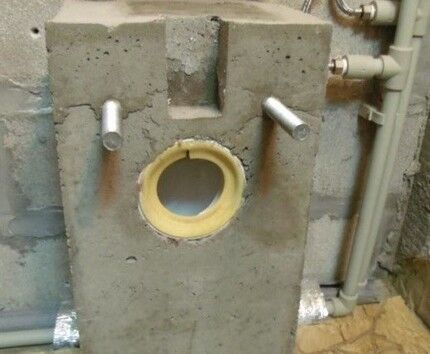
The next step is concreting. This must be done by installing foam plastic in the place where the drain hole will be. Remember that the concrete will finally harden only after 28 days.
After this, you can remove the formwork and make sure that in front of us there is a monolithic concrete block with pins coming out of it and an open, fixed coupling. A toilet is mounted to the front of the block, and a tank is placed on the base itself.
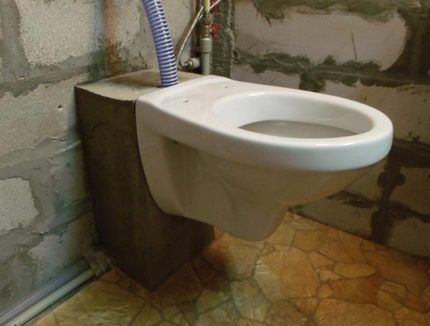
The procedure for installing a bowl to a concrete base is no different from installing a floor-standing toilet. You need to install the bowl on the pins, tighten the nuts, connect and seal the drain. Lastly, a drain tank is placed on the concrete base.
As you can see, this method of installing a hanging model is much cheaper and easier than working with the installation. But, to be honest, the result is not much different from a floor-standing toilet.
Conclusions and useful video on the topic
The information you just read will be perceived much better if you supplement it with a video. We invite you to watch the installation of a wall-hung toilet with installation filmed on video.
The range of plumbing fixtures is expanding: toilets are being improved, updated, and become more and more attractive. But modern models, as a rule, are more expensive than traditional ones.
We recommend not to skimp on the quality and design of the product, but to save on installation by doing it yourself. This will help you buy what you like without significant damage to the family budget.
Tell us about how you installed a wall-hung toilet in your house/apartment.It is possible that you know technological nuances that will be useful to site visitors. Please write comments, post photos, share your impressions and ask questions in the block below.




A wall hung toilet does look better, I totally agree with that. It is much more convenient to wash; dust does not accumulate on the leg. But it’s just much more difficult to install than a floor-mounted one. I set up the installation for myself, but I fiddled with it for a long time, I won’t do this myself again. I took a square bowl, unusual, but, as it turned out, very convenient. True, now I’m afraid that nothing will break; valves in toilets are a weak point.
It may look better, but that's where all the advantages end. The fact that it’s easier to clean - you’re not cleaning a public toilet with 10 toilets, so this is a debatable advantage. So maybe you shouldn’t chase fashion and overpay?
There is no need to be so critical of these kinds of decisions. It is clear that from a practical point of view, a conventional toilet with a floor-mounted installation is the optimal solution.
But design innovations are also in demand; if one person chooses simplicity and practicality, then another chooses an original design. In this regard, wall-hung toilets have proven themselves well.
If people want a wall-hung toilet, then there is no need to run them in the opposite direction and judge by themselves. The article provides informative material and highlights the pros and cons. The only thing I would like to add is recommendations on access to communications.It is relevant for installing a toilet with a hidden type of installation, you need to make an inconspicuous camouflaged hatch with access to communications.